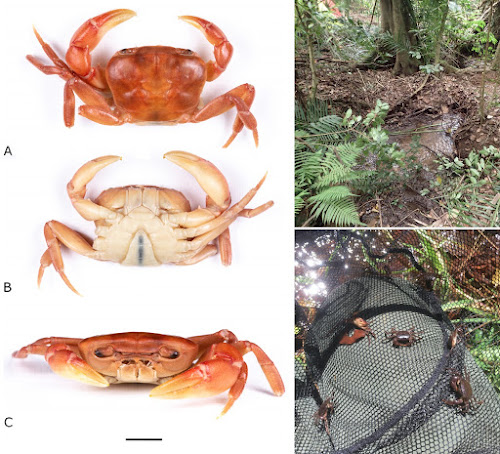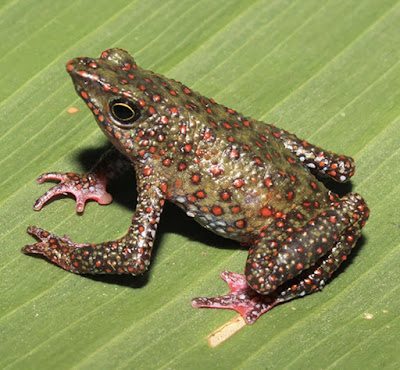[Most Recent Entries] [Calendar View]
Thursday, September 24th, 2020
| Time | Event | ||
| 9:34a | [Crustacea • 2020] Potamonautes licoensis • Phylogenetics of the Freshwater Crab (Potamonautes MacLeay, 1838) Fauna from ‘Sky Islands’ in Mozambique with the Description of A New Species (Brachyura: Potamonautidae)
Abstract Patterns and processes of cladogenesis among taxa living on the Mozambique ‘sky islands’ remain poorly studied. During the present study, we report on a new freshwater crab species from Mount Lico, an inselberg and ‘sky island’ in the Zambezia Province of Mozambique. Phylogenetic analyses using three mitochondrial DNA sequence loci (12S rRNA, 16S rRNA and COI) were used to determine the evolutionary placement of the freshwater crab specimens from Mount Lico. The freshwater crab specimens from Mount Lico were retrieved sister to Potamonautes choloensis. The new species, Potamonautes licoensis sp. nov., is described and compared with other southern African freshwater crab species. Divergence time estimations for the Mozambican freshwater crab species suggest a Miocene / Plio–Pleistocene diversification. Some endemic ‘sky island’ species form an early branching and are sister to other predominantly East African species, while other ‘sky island’ species are more recently derived and nested within a predominantly southern African clade. The present study presents the description of the fourth endemic freshwater crab species from Mozambique and suggests that the species diversity in the country is likely highly underrepresented, reiterating the call for renewed systematic surveys. An argument for the conservation of these mountainous ‘sky islands’ is presented. Keywords: alpha taxonomy; species diversity; novel lineages; sky island; conservation Infraorder Brachyura Latreille, 1802 Superfamily Potamoidea Ortmann, 1896 Family Potamonautidae Bott, 1970 Subfamily Potamonautinae Bott, 1970 Genus Potamonautes MacLeay, 1838 Potamonautes licoensis sp. nov. Diagnosis Carapace: highly flat (CH/CL = 0.44) (Table 1); postfrontal crest well-defined, complete, lateral ends meeting anterolateral margins; epigastric crests faint, median sulcus between crests short, not forked posteriorly; exorbital, epibranchial teeth reduced to granules; anterolateral carapace margin with small tooth epibranchial (Figs 2A–C, 5A). Third maxilliped: ischium with distinct vertical sulcus (Fig. 3C); s3/s4 complete, V-shaped, deep, midpoint almost meeting anterior margin of sterno-pleonal cavity; margins of s4 low, not raised (Fig. 2B). Cheliped: dactylus (moveable finger) slim, highly arched, enclosing oval interspace, with three larger teeth interspersed by smaller teeth along length; propodus (fixed finger) with four larger teeth interspersed by smaller teeth along length (Fig. 2A–C); carpus inner margin distal tooth large, pointed, proximal tooth reduced to granules (Fig. 3A); medial inferior margin of merus lined with series of small granules terminating distally at small, low distal meral tooth, lateral inferior margin smooth. G1 terminal article: ⅓rd length of subterminal segment; first third straight in line with longitudinal axis of subterminal segment, middle part directed outward at 45°, widened by raised rounded ventral lobe, tip curving sharply upward (Fig. 3A–B). Etymology: Named for Mount Lico, from where the species was first collected. Type locality: Mount Lico, Zambezia Province, Mozambique. Habitat: Primary rain forest streams on top of Mount Lico, Zambezia Province, Mozambique. Frequently found under small stones in first order streams (Fig. 5A). Distribution: Known from Mount Lico, Zambezia Province, Mozambique. More recently, the species has also been collected from Mount Nallume (Daniels pers. obs.). Savel R. Daniels, Gabriela B. Bittencourt-Silva, Vanessa Muianga and Julian Bayliss. 2020. Phylogenetics of the Freshwater Crab (Potamonautes MacLeay, 1838) Fauna from ‘Sky Islands’ in Mozambique with the Description of A New Species (Brachyura: Potamoidea: Potamonautidae). European Journal of Taxonomy. 716; 1–23. DOI: 10.5852/ejt.2020.716 | ||
| 9:54a | [Herpetology • 2020] Atelopus moropukaqumir • A New Species of Atelopus (Anura: Bufonidae) from southern Peru
Abstract Keywords: Amphibia, Andes, Ayacucho, Batrachochytrium dendrobatidis, chytridiomycosis, harlequin frog Atelopus moropukaqumir Valia Herrera-Alva, Vladimir Díaz, Ernesto Castillo, César Rodolfo and Alessandro Catenazzi. 2020. A New Species of Atelopus (Anura: Bufonidae) from southern Peru. Zootaxa. 4853(3); 404–420. DOI: 10.11646/zootaxa.4853.3.4 |
| << Previous Day |
2020/09/24 [Calendar] |
Next Day >> |







